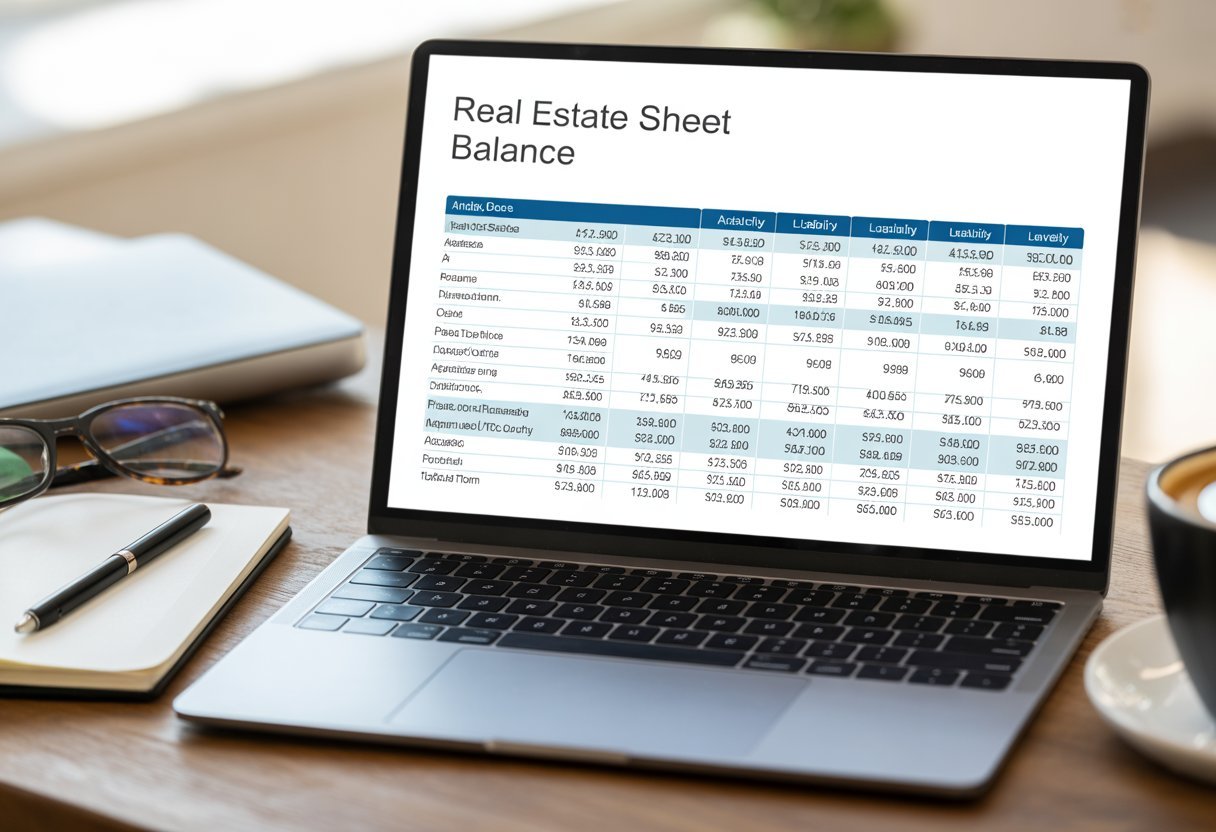A real estate balance sheet provides a clear snapshot of your property investments and financial position at any given moment. Your balance sheet tracks the true value of your real estate assets by measuring what you own against what you owe, revealing your total equity position and investment health.
Managing rental properties or real estate investments requires careful financial tracking, and a real estate balance sheet serves as your financial compass. By documenting your assets, liabilities, and equity, you gain essential insights for making informed investment decisions and monitoring property performance.
Creating and maintaining a rental property balance sheet helps you track the financial health of each property in your portfolio. This vital tool enables you to spot trends, identify potential issues, and make data-driven decisions about your real estate investments.
Key Takeaways
- Balance sheets reveal your real estate portfolio‘s true financial position by comparing assets to liabilities
- Regular balance sheet monitoring helps identify investment opportunities and potential risks
- Accurate financial tracking through balance sheets enables better decision-making for property acquisitions and management
Understanding the Real Estate Balance Sheet
A balance sheet provides critical insights into your real estate investments by measuring assets against liabilities to determine net worth at a specific point in time. This financial snapshot helps track property value, debt obligations, and investment performance.
What Is a Balance Sheet?
A real estate balance sheet reports property worth by documenting all financial positions in a structured format. Think of it as a financial photograph that captures your investment’s status at a precise moment.
Your balance sheet follows a fundamental equation: Assets = Liabilities + Equity. This mathematical relationship ensures everything balances perfectly.
The document helps you track financial health, secure financing, and make informed investment decisions. Regular balance sheet reviews reveal trends in property performance and debt management.
Role of Balance Sheets in Real Estate
Balance sheets serve as vital tools for property management and investment analysis. They help you monitor cash flow, assess debt levels, and evaluate investment returns.
Financial statements provide detailed insights into property performance and guide strategic decisions about:
- Property acquisitions and sales
- Refinancing opportunities
- Maintenance investments
- Risk assessment
These documents also help lenders evaluate your creditworthiness and investors understand potential returns.
Key Components of a Real Estate Balance Sheet
Real estate balance sheets contain three main elements:
Assets:
- Property values
- Cash reserves
- Rent receivables
- Security deposits held
Liabilities:
- Mortgage balances
- Property taxes due
- Maintenance fees
- Security deposit obligations
Equity:
- Initial investment
- Retained earnings
- Capital improvements
- Accumulated depreciation
Each component requires regular updates to maintain accuracy and usefulness for decision-making.
Assets on a Real Estate Balance Sheet
A real estate balance sheet tracks all assets owned or controlled by your property business. These assets represent resources that generate economic value, from physical properties to liquid cash.
Real Estate Assets
Physical properties form the core of your real estate asset portfolio. This includes residential buildings, commercial properties, land, and any property improvements.
Your buildings and equipment should be listed at their current market value. This includes major building systems like HVAC, elevators, and security systems.
Property improvements such as renovations, additions, or landscaping upgrades also count as assets. These improvements typically increase the property’s value and income potential.
Investments and Securities
Real estate investment trusts (REITs) and property-backed securities represent significant investment assets on your balance sheet.
Mortgage-backed securities and real estate mutual funds can diversify your portfolio beyond physical properties.
Joint venture investments and partnership interests in other real estate projects should be listed separately with their current valuations.
Cash and Accounts Receivable
Current assets include cash and accounts receivable from rental income, property sales, or service fees.
Your operating accounts maintain funds for daily expenses and property maintenance.
Reserve accounts hold cash for future repairs, property taxes, and insurance payments.
Security deposits from tenants count as both assets and liabilities on your balance sheet.
Other Assets and Accumulated Depreciation
Lease agreements and tenant contracts represent intangible assets with measurable economic value.
Prepaid expenses like insurance premiums or property taxes are listed as current assets.
Accumulated depreciation reduces the book value of your properties over time. Track this separately for each asset.
Office equipment, property management software, and maintenance tools count as smaller but essential business assets.
Liabilities and Equity in Real Estate
A real estate balance sheet tracks your financial obligations and ownership value through liabilities and equity calculations. These components directly impact your property investment’s financial health and long-term profitability.
Common Liabilities: Notes Payable and More
Mortgage loans represent the primary liability in real estate investments. Your property-related debts include mortgage principal, accrued interest, and property taxes.
Credit lines and vendor payments form additional liabilities that affect your cash flow. You must track these obligations monthly to maintain accurate financial records.
Security deposits from tenants count as liabilities until returned. These funds require separate accounting as they don’t represent your capital.
Property maintenance expenses and utility bills create short-term liabilities that need regular monitoring.
Equity Method in Real Estate
Your equity position equals the property value minus outstanding liabilities. This calculation reveals your actual ownership stake in the investment.
Changes in property value directly affect your equity position. Market appreciation increases your equity, while depreciation reduces it.
Principal payments on your mortgage build equity over time. Each monthly payment shifts money from the liability to the equity column.
Amortization and Its Impact
Mortgage amortization schedules show how your payments reduce principal over time. Early payments mostly cover interest, while later ones target principal reduction.
Your loan terms determine the amortization period. Shorter terms mean higher monthly payments but faster equity building.
Regular amortization tracking helps predict when you’ll reach specific equity milestones.
Total Assets Versus Liabilities
Property value plus cash reserves constitute your total assets. Regular asset valuations ensure accurate balance sheet reporting.
Your debt-to-asset ratio measures investment risk. Lower ratios indicate stronger financial positions.
Cash flow analysis helps ensure assets generate enough income to cover liabilities. Maintaining positive cash flow supports long-term investment stability.
Monitor market conditions that might affect your asset values. Property improvements can increase asset worth while offsetting depreciation.
The Role of Financial Statements in Real Estate
Financial statements provide critical insights into property performance and help make informed investment decisions. They act as essential tools for measuring profitability, tracking cash flows, and evaluating asset values.
Differences Between Balance Sheet and Income Statement
The balance sheet presents your assets, liabilities, and equity at a specific moment, like a snapshot of financial position. It shows property values, outstanding mortgages, and ownership stakes.
Income statements track revenue and expenses over time, revealing property performance through metrics like:
- Net Operating Income (NOI)
- Rental income
- Property management fees
- Maintenance costs
These two statements serve distinct yet complementary purposes. Your balance sheet measures wealth accumulation, while income statements track profitability.
Integration With Other Financial Documents
Cash flow statements bridge the gap between your income statements and balance sheets by tracking money movement. They help you monitor:
- Rent collections
- Mortgage payments
- Capital improvements
- Operating expenses
Financial reports work together to create a complete picture of property performance. Your statement of owner’s equity connects balance sheet changes to income statement results.
Importance for Asset Management
Effective asset management relies on regular financial statement analysis to optimize property performance.
Key metrics to track include:
- Return on Investment (ROI)
- Debt Service Coverage Ratio
- Occupancy rates
- Operating expense ratios
These numbers guide your decisions about:
- Property improvements
- Rent adjustments
- Refinancing opportunities
- Hold/sell strategies
Regular review of these metrics helps identify trends and potential issues before they impact property value.
Applications for Commercial Real Estate and Rental Property

A well-structured balance sheet provides critical insights into property assets, liabilities, and equity positions while enabling informed decision-making for both investment properties and commercial real estate ventures.
Real Estate Investment Structures
Different investment structures require specific balance sheet approaches. For real estate investment analysis, you’ll need to track assets and liabilities at both property and entity levels.
Single-property LLCs benefit from dedicated balance sheets that isolate each property’s performance. This allows you to evaluate individual asset performance without commingling funds.
Portfolio structures require consolidated balance sheets showing combined holdings. You should maintain separate sub-schedules for each property while rolling them up into a master sheet.
Balance Sheets for Rental Property Owners
Your rental property balance sheet must capture all property-related assets including the building value, improvements, and security deposits held.
List all outstanding mortgages, maintenance reserves, and tenant deposits as liabilities. Track depreciation separately to understand true equity position.
Monthly updates help identify cash flow patterns and equity buildup. Include both operating accounts and capital improvement funds as current assets.
Commercial Real Estate Considerations
Commercial lease applications require detailed balance sheets showing tenant financial positions. Track triple net lease obligations separately from base rent.
Break out tenant improvements and leasing commissions as separate line items. This helps analyze the true cost basis of each tenant relationship.
Capital expenditure reserves deserve their own line item to plan for major repairs. Include both short-term maintenance funds and long-term replacement reserves.
Utilizing Balance Sheets for Acquisition, Budgeting, and Efficiency
Balance sheets provide critical insights that drive successful real estate investment decisions and operational management. A properly analyzed balance sheet reveals key financial metrics and ratios that inform strategic planning.
Guiding Acquisition Decisions
Your financial modeling for acquisitions should start with a thorough balance sheet review to evaluate potential investments. Focus on the asset-to-liability ratio and working capital position to assess financial health.
Compare the target property’s balance sheet metrics against similar properties in your portfolio to identify any red flags or opportunities.
Key metrics to examine:
- Debt-to-equity ratio
- Current ratio
- Quick ratio
- Return on assets (ROA)
Analyze historical balance sheets to spot trends in property performance and maintenance costs that could impact your acquisition decision.
Budgeting and Financial Planning
Your balance sheet serves as a foundation for creating accurate budgets and forecasts. Track changes in asset values and liabilities to adjust your financial planning accordingly.
The real estate balance sheet analysis helps you:
- Project future capital requirements
- Plan for major renovations
- Schedule debt payments
- Allocate resources efficiently
Break down expense categories to identify areas where costs can be reduced or controlled better.
Create monthly variance reports comparing actual results to budgeted figures to maintain financial discipline.
Enhancing Operational Efficiency
Use your balance sheet data to optimize day-to-day operations and improve property performance. Monitor working capital ratios to ensure sufficient cash flow for regular operations.
Track maintenance reserves and capital improvement funds to prevent unexpected cash shortfalls.
Key efficiency metrics:
- Operating expense ratio
- Net operating income (NOI)
- Occupancy rates
- Maintenance cost per square foot
Regular balance sheet reviews help identify underperforming assets and opportunities for cost reduction or revenue enhancement.
Regulatory Considerations and Licensing

Real estate brokers and companies must maintain strict compliance with financial reporting standards while adhering to licensing requirements that directly affect their balance sheets and financial positions.
Compliance and Reporting Requirements
Real estate brokers must maintain accurate financial records and balance sheets as part of their licensing obligations. You need to keep detailed documentation of all transactions, trust account balances, and commission distributions.
Your balance sheet must accurately reflect all assets, liabilities, and equity positions. Keep separate records for personal and business accounts to maintain transparency.
Regular audits may be required by state regulatory bodies. You must submit annual operating statements and balance sheets when requested by authorities.
Impact of Licensing on Financial Statements
Your license status directly affects how you report certain items on your balance sheet. Professional licenses must be listed as intangible assets if purchased.
You need to maintain minimum capital requirements as specified by your state’s licensing board. This affects your asset allocation and cash reserves.
License renewal fees and continuing education costs must be recorded as operating expenses. These recurring costs impact your company’s financial position and should be budgeted accordingly.
Regulatory fines or penalties for non-compliance become immediate liabilities on your balance sheet and must be reported promptly.
Frequently Asked Questions

Real estate balance sheets contain vital financial data that helps track assets, liabilities, and equity positions for property investments. These statements serve as essential tools for evaluating property performance and making informed investment decisions.
What are the key components of a balance sheet for rental properties?
Your rental property balance sheet must include three main components: assets, liabilities, and equity. Assets encompass cash, accounts receivable, and property values.
Liabilities consist of mortgages, property taxes owed, and maintenance expenses payable.
Owner’s equity represents the difference between total assets and total liabilities, showing your actual ownership stake in the properties.
How does one interpret a real estate balance sheet to assess financial health?
Start by examining the ratio between current assets and current liabilities to determine liquidity position. A ratio above 1.0 indicates good short-term financial health.
Review the debt-to-equity ratio to assess leverage levels. Lower ratios typically suggest less financial risk.
Compare property values to outstanding mortgages to calculate equity positions in each asset.
What are typical line items found in a real estate developer’s balance sheet?
Land inventory and construction in progress appear as major asset entries. Construction loans and development costs show up under liabilities.
Pre-sold units and deposits from buyers are recorded as current liabilities.
Equipment, permits, and architectural plans get listed as fixed assets.
How can investment property balance sheets differ from residential property balance sheets?
Investment properties include items like tenant security deposits, rental income receivables, and property management fees.
Residential balance sheets focus more on personal mortgage obligations and household maintenance expenses.
Investment properties often carry additional insurance liabilities and replacement reserves not found in residential statements.
What are the common financial ratios and metrics derived from a real estate balance sheet?
Calculate return on equity by dividing net income by total equity to measure investment performance.
The debt service coverage ratio shows your ability to make mortgage payments from property income.
Asset turnover ratios help evaluate how efficiently you’re using property investments to generate revenue.
What templates are available for creating a real estate balance sheet in Excel?
Basic templates include pre-formatted cells for assets, liabilities, and automatic equity calculations.
You can find customizable worksheets with built-in formulas for calculating key financial ratios and performance metrics.
Professional templates often include separate tabs for multiple properties and consolidated reporting features.




